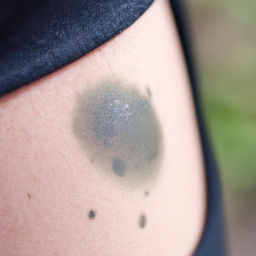Paintball Bruise Fun Injury or Serious Threat
Table of Contents []
Paintball Bruise
Painball Bruises: A Comprehensive Guide
Introduction
Paintball is a rapidly expanding sport throughout the world that involves firing paintballs from either a gas or electric powered gun at opposing players. The goal of paintball is to mark the other team with the paintballs, eliminating its players and ultimately winning the game. While it is exciting and enjoyable, the sport is not without risk of injury. One of the more pronounced injuries sustained during paintball is the often intense bruising. In this article, we will delve into the topic of paintball bruises, from its history to the managing of bruising.
A History of Paintball and Bruising
Paintball has been around in various forms since the early 1980s. The game was initially designed as a training exercise for police and military personnel. In the early 1990s, the game was adopted as a recreational sport among sport enthusiasts and gained huge momentum in the early 2000s. As paintball gained traction, so did cases of minor injury.
Common paintball related injuries include, but are not limited to: bruising, sprains, and minor lacerations. Bruising during paintball games is unfortunately a common occurrence, as the firing of paintball guns creates a significant enough force to cause damage to the exposed skin of a player. While there is a protective gear available to the players, it is by no means perfect in protecting a person from bruising, as a paintball can, in some cases, travel light speed.
Sport Regulations
The sport sees a wide array of regulations implemented across different countries and regions. As with any sport, the goal of regulations is to ensure the safety of players, minimize risks of injury, and in general, create a fair playing field for all. The country regulations vary significantly, with some regions requiring players to wear additional protective gear, regulating the speed of the paintball guns, and limiting paintball arena sizes.
Paintball Gun Types
Players of paintball may choose to use either an electric or gas powered paintball gun. Both have their advantages and disadvantages. Gas powered paintball guns are the traditional form of paintball gun and, thanks to their smaller size and lack of additional wiring, may be the choice for more experienced paintball players. On the other hand, electric paintball guns offer greater accuracy and better performance, enabling the players to make shots with greater precision and control. Electric paintball guns are also the choice for beginners, as they are more comfortable to use after a day of practice.
Managing Bruising
The goal of any paintball player should be to minimize the risk of bruising while participating in the game. While protective gear such as neck guards, helmets, and face masks can reduce the risk, some degree of bruising is still likely to occur. As such, it is important for players to understand how to manage their bruising in the aftermath of the game.
The best way to manage any bruising after a paintball game is to immediately apply a cold compress to the affected area. This will reduce the risk of further bruising occurring and, if done quickly, may even be able to reduce the inflammation. Additionally, over the counter pain medication can be taken to reduce pain and inflammation. It is also important to make sure the skin is kept moisturized and hydrated during the days following the game. The skin may be sensitive to many products, so it is advised to test different kinds of creams and lotions to ensure the best one is used.
Insights
It is clear that paintball bruising is a common occurrence during a game of paintball. While protective gear is good for minimizing the occurrence of bruising, the best way to reduce the risk of bruising is to understand what causes the bruising and how best to manage it. Players of paintball should be aware of the risks, be diligent in their protective measures, and use adequate at-home care to reduce the extent of the bruising.

Previous Page
Next Page